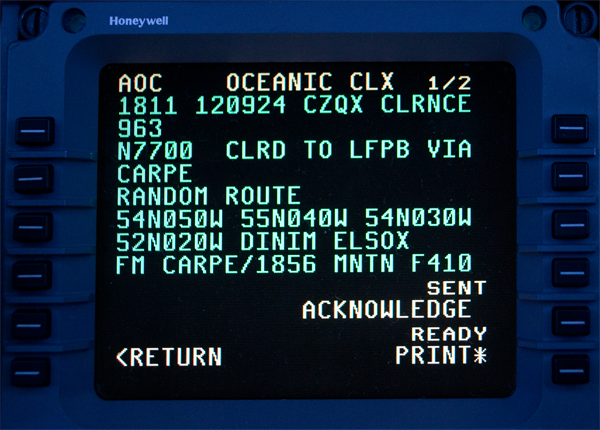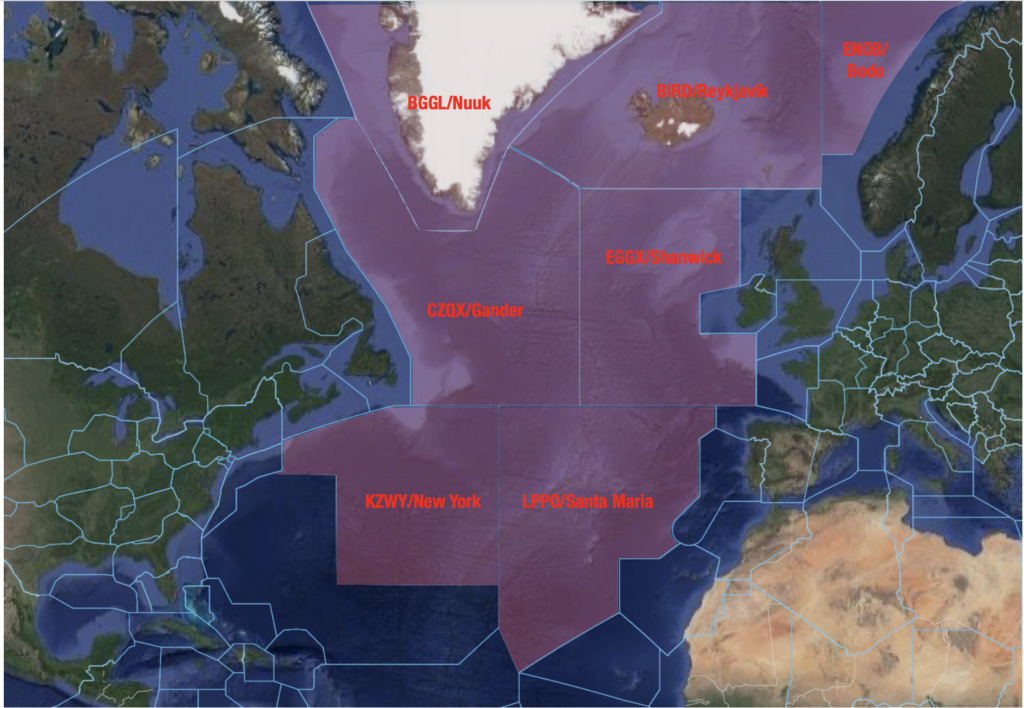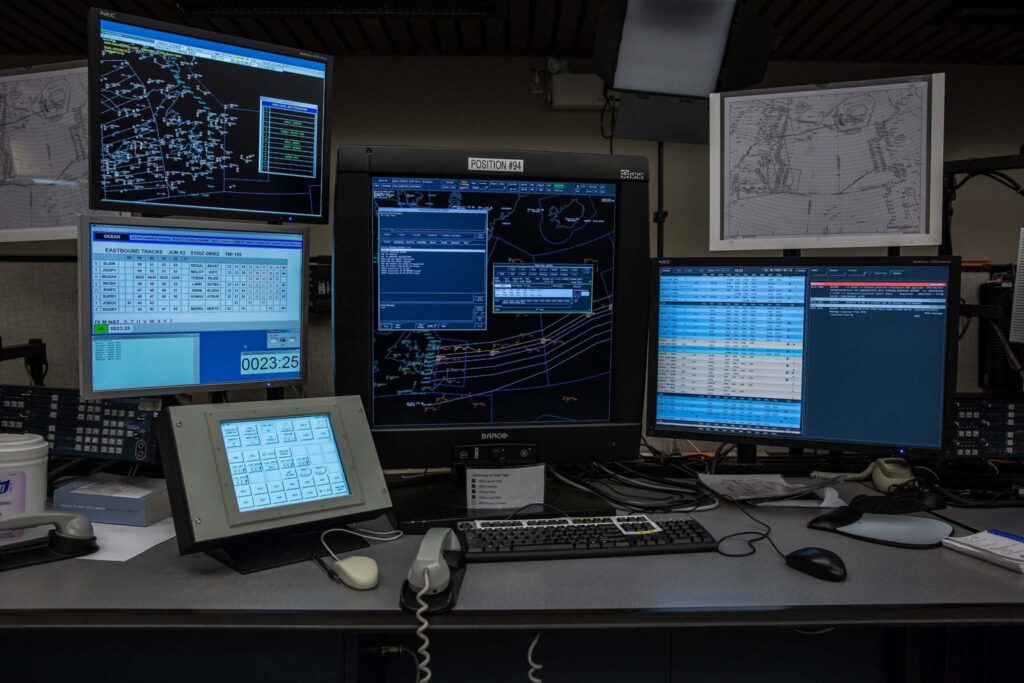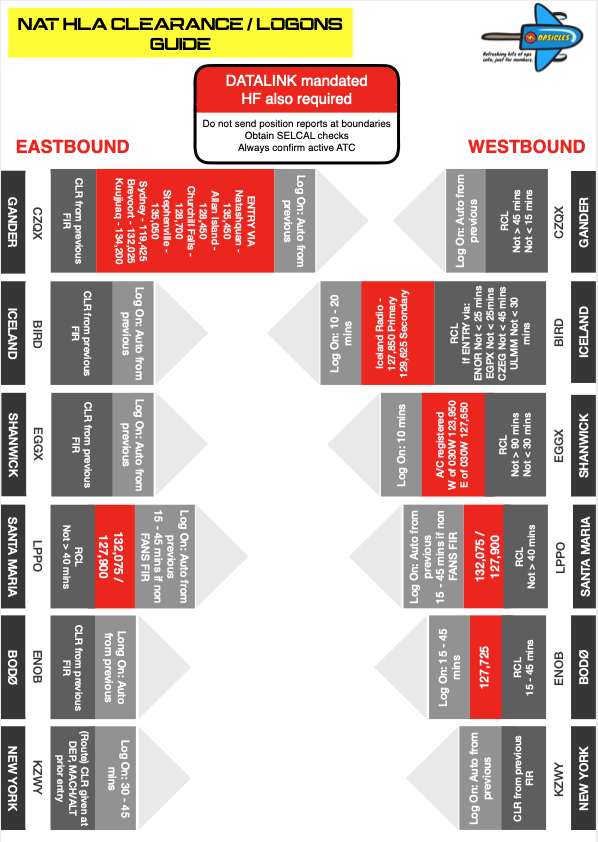You carefully type it up, have the other pilot check it, then hit send… and wait… your airplane is creeping closer and closer to the Oceanic Entry Point and still no reply, and then DISASTER! Clearance Request Rejected! Or worse still, you just never get a response…
Here are some hints, tips (and actual procedures) related to getting your Oceanic Clearance for the NAT HLA. And what to do if you don’t…
How to get your clearance.
There is a datalink mandate across the vast majority of the NAT HLA which means everything has headed towards “messages” rather than voice. Why? Because it’s easier and there is a lot less risk of mess-ups and mix ups. So, most likely, you are going to be requesting your clearances via “message” as well. The system it goes through is generally the Arinc 623 – the same you use for things like your D-ATS. Contrary to CPDLC, A623 exchanges don’t require previous notification. But enough of that technical schtuff.
If you ttake a look through the North Atlantic section of *whichever manual* you are using and somewhere under COM and ATC Communications you will find a section on ‘Oceanic Clearance Request via Data Link’. Each OCA has its own thing to say in terms of times to send it and reverting to voice, but in general the message you want to send when requesting your clearance is the same for them all.
You need to include Entry Point, ETA for Entry Point, Requested Mach Number, Requested Flight Level and add a remark (RMK/) indicating preferred alternative (another NAT Track) and MAX FL. You only have 80 characters available to you so don’t go adding extra comments in, it will probably just get rejected.
After sending your clearance request you should receive an advisory message which says something like this –
“IF NO CLEARANCE RECEIVED WITHIN 30 MINUTES OF OCEANIC ENTRY PONT REVERT TO VOICE PROCEDURES END OF MESSAGE”
If you don’t receive this within about 5 minutes of sending the question, something has possibly gone wrong. Try sending again if you can still meet the minimum time to boundary for a request, or revert to voice.

A nice example of your Oceanic Clearance
The times you want to think about sending your RCL through at vary from OCA to OCA, as do the logon addresses, so here is a rundown of each one…

Shanwick
- The logon is EGGX.
- Shanwick want your request sent no later than 30 minutes before the OCA boundary, but no earlier than 90 minutes or they’ll reject it.
- If you haven’t received your clearance and are within 15 minutes of the OCA boundary then revert to voice. If you are East of 020W then try Shanwick Radio on 127.9 to help reduce chatter on HF. Only give HF a go if you are within 40 minutes of the boundary and having issues getting VHF signal.
- For Shanwick Oceanic you have two frequencies – 123.950 is for aircraft registered in States West of 030W. 127.650 is for aircraft registered in States East of 030W.

ATC NAT Controller station
Gander
- The logon is CZQX
- The request should be sent just after the aircraft gets within 90 minutes of the OEP. If you don’t receive the advisory message within 5 minutes, or if you haven’t received a clearance and are within 30 minutes of the OEP then revert to voice.
- Gander is a little tricky with working out which frequency to use. It comes down to where you are routing via:
- Natashquan 135.460
- Allan’s Island 128.450
- Churchill Falls 128.7
- Stephenville 135.050
- Sydney 119.425
- Brevvoort 132.025
- Kuujjuaq 134.2
Reykjavik
- The logon is BIRD.
- How far in advance you need to request your RCL depends on where you are entering from (which CTA). The time is the minimum time from the BIRD CTA Entry Point that they should receive your RCL by and the general rule is 20-25 minutes.
- Stavanger (ENOR) 25 mins
- Scottish (EGPX) 25 mins
- Edmonton (CZEG) 45 mins
- Murmansk (ULMM) 30 mins
- If you have Inmarsat datalink then you probably won’t be able to get your clearance while north of 82°N. If you’re on an Iridium or HF datalink system then you’re in luck.
- If you have to get your clearance via voice then you can try Iceland Radio on VHF Primary 127.850 or Secondary 129.625. They are also on the HF B, C and D families but you’re having a bad day if it’s reaching that level.
Bodø
- The logon is ENOB.
- Request your clearance at least 30 minutes before the NAT region boundary. Revert to voice if you’re within the 20 minutes mark on 127.725.
Santa Maria
- The logon is LPPO.
- Send your request 40 minutes before the OEP. If you need to request clearance by voice then talk to Santa Maria Radio on 127.9 or 132.075.
New York
- The logon is KZWY.
- This works a little differently if you are routing from the US because your clearance is going to be included in your departure clearance (since you’re basically in the area anyway). You can logon 30-45 minutes before.
What to do if you don’t get a clearance?
Shanwick is really the main one to worry about – having a clearance (being in contact with ATC) is pretty darned important there because it is such a big area and extremely busy.
Always give yourself time. If a clearance isn’t received, try by voice. If you can’t get through then try other frequencies and ATCs. If you reach a boundary without a clearance then chances are it’s because you have some sort of comms loss in which case this is now your bigger concern.
In theory, you could enter the NAT HLA (aside from via Shanwick) without a clearance (with loss of comms) and fly as per your flight plan route (Mach and Levels) but it really, really isn’t advisable.
What to do when you do get your clearance.
It goes without saying that first up you need to acknowledge it with ATC. After that you’ll want to check it, and get the other pilot to as well. Printing it out is a good way to do this if you have that option. “Checking it” means checking what you’ve been cleared to do is what you’re asking the aircraft to do via its nav computer.
Finally, make sure you really are flying it by monitoring it and doing your plotting (or equivalent) checks. You can read about that here if you’re not sure how.
A helpful summary.
We created a little Opsicle – a refreshing bit of ops info, just for members. Which means if you are an OPSGROUP member you can click on the pic to get yours. This one summarises all the logon info we wrote about above!
Where is the official info?
The info is contained in AIPs, and some of it within ICAO NAT Doc 007.
We might have missed some things, or made a mistake so if you spot one let us know!
More on the topic:
- More: Datalink in Europe: What Are The Rules?
- More: Back to the Radio: Gander Goes Voice-Only Pre-Oceanic
- More: NAT Crossing after GPS spoofing: a guide
- More: US Domestic Enroute CPDLC Update
- More: The North Atlantic Datalink Mandate – 2024 update
More reading:
- Latest: Crossing the Quiet South: From Australia to Argentina
- Latest: Major runway shutdowns ahead at KVNY/Van Nuys
- Latest: New FAA Airspace Warnings for Venezuela and Puerto Rico
- Safe Airspace: Risk Database
- Weekly Ops Bulletin: Subscribe
- Membership plans: Why join OPSGROUP?












 Get the famous weekly
Get the famous weekly 






Rebecca…please contact me for clarification on your article…phone available 678-793-6190
Clearances CAN be received by CPDLC. We are not approved for ACARS clearance delivery at the moment and receive oceanic clearances via CPDLC automatically, without request. Just an fyi.
Good morning, NAT clearances are not received by CPDLC but ACARS. You do not logon, but do send the RCL to the appropriate address by ACARS. Both Boeing and Airbus have an ARINC 623 application for this purpose, separate to CPDLC. In the U.S. CPDLC is used for domestic clearances with a logon to KUSA required.
Regards, Mark
Good morning. Thanks for the article, but there’s one major problem with it. You’re saying we get our clearances from CPLDC when that’s not the case. You’ll see that on the request page it says “AOC” at the top left. That’s because the clearance comes from the ATS part of the box and NOT the CPDLC side.
We get our oceanic clearances the same place we get ATIS from. There is an option for clearance within the CPDLC menu, but nobody in the NAT is using that right now.
This can all be very confusing, especially when getting a DCL from CPDLC in the U.S. is using the same terminology for the ARINC 623 DCL in Europe via the AOC – which isn’t CPDLC.
Thanks in advance for your thoughts.
Ed
Hi Ed, Mark. Thanks for this – that’s a total oversight (and woeful lack of tech knowledge) on my part. In my previous type we used the same interface for requests and I did rather lazily/stupidly assume what it was sending via, but on checking the manual you’re right – the system is the A623 and not CPDLC. I’ll amend that now. Thanks again.